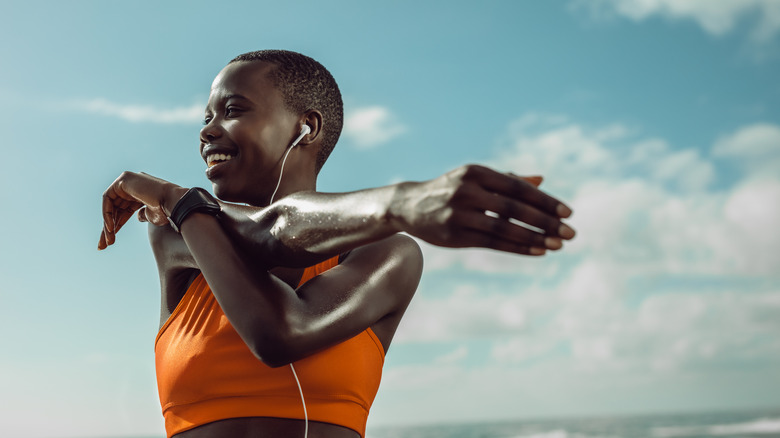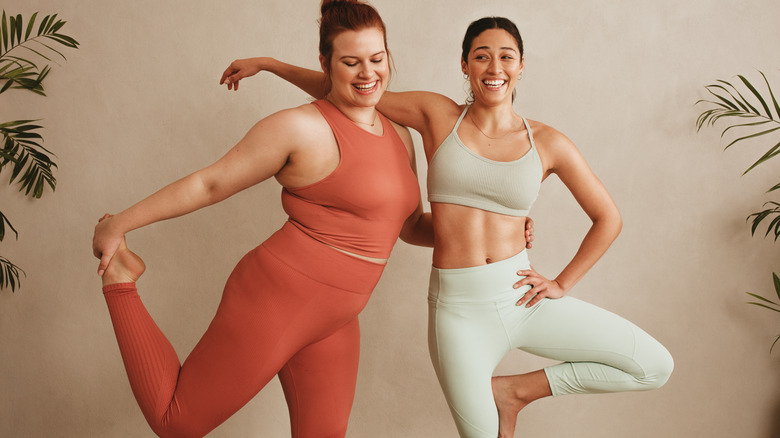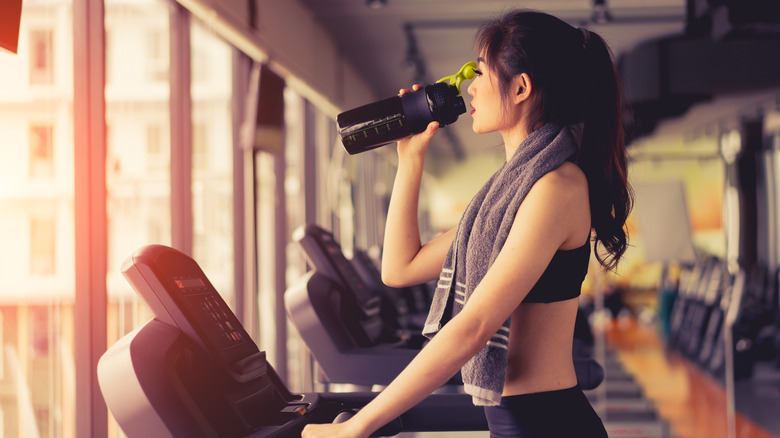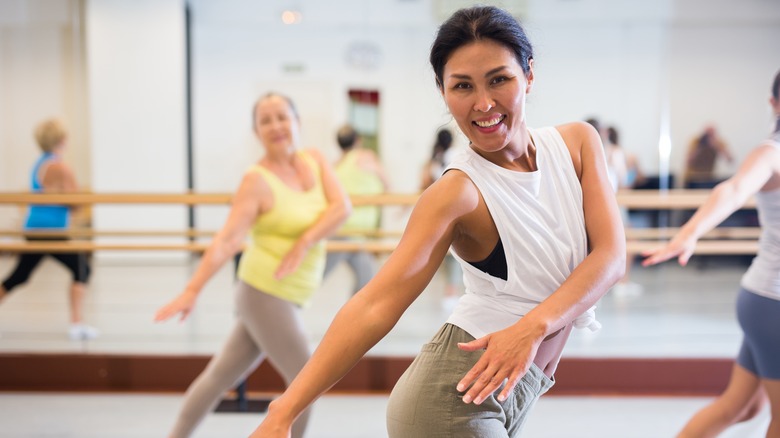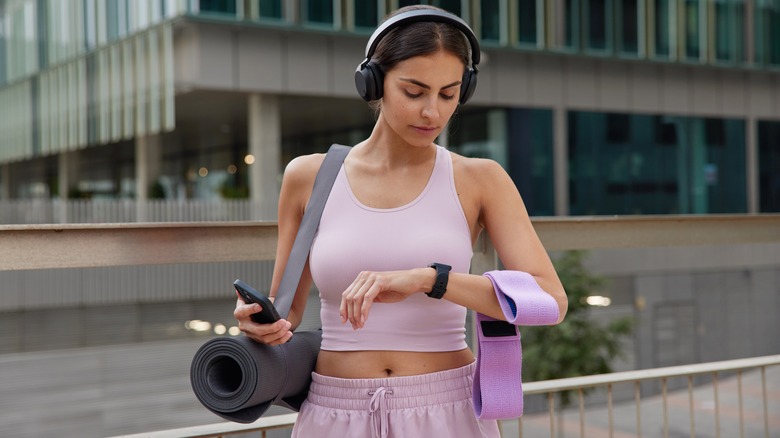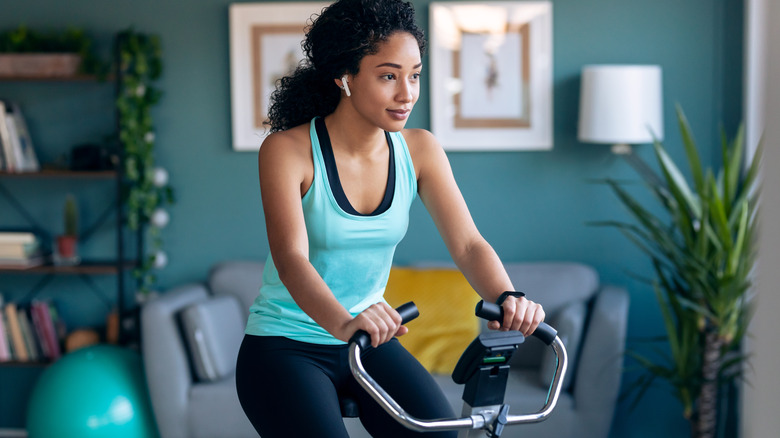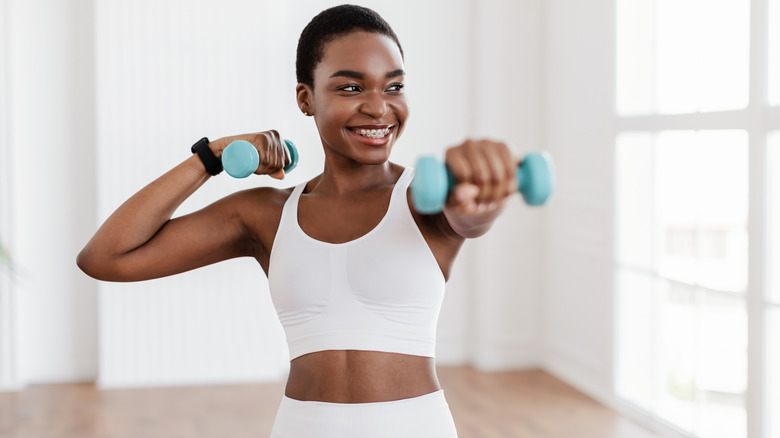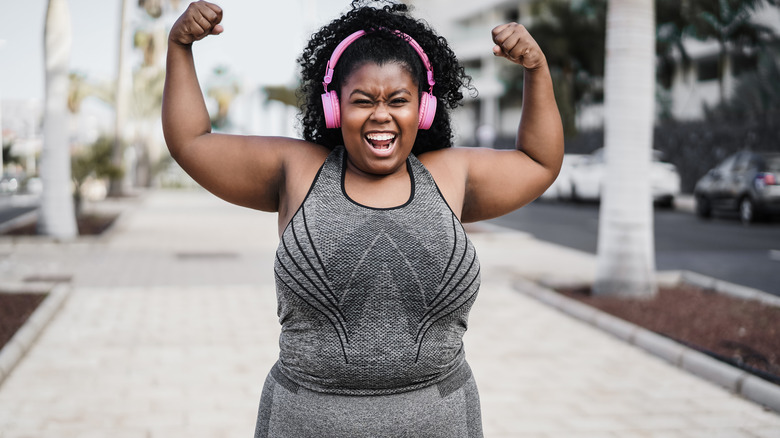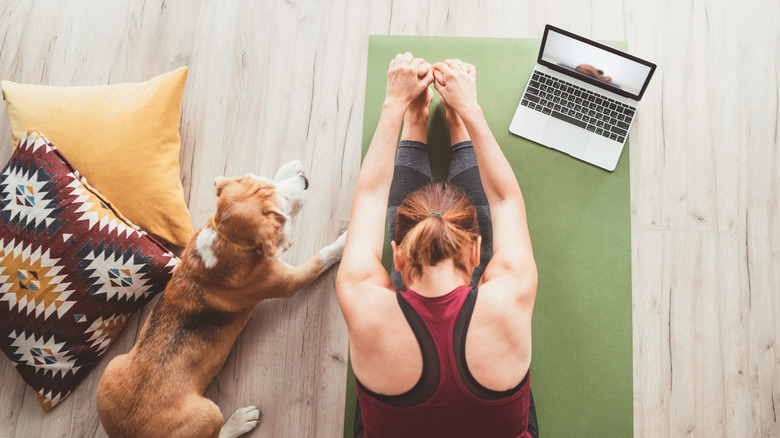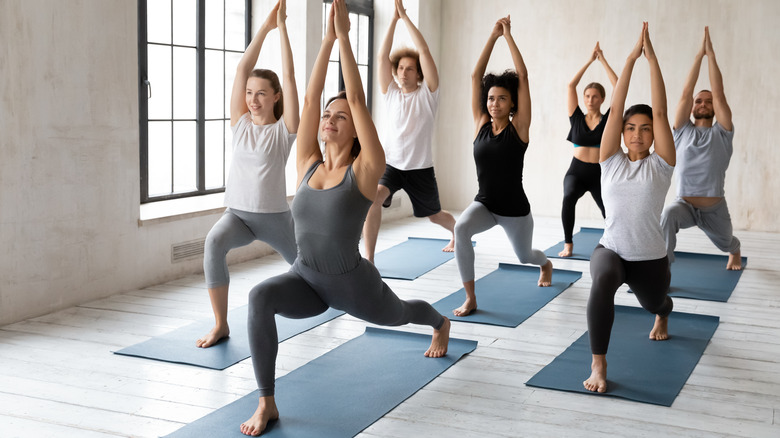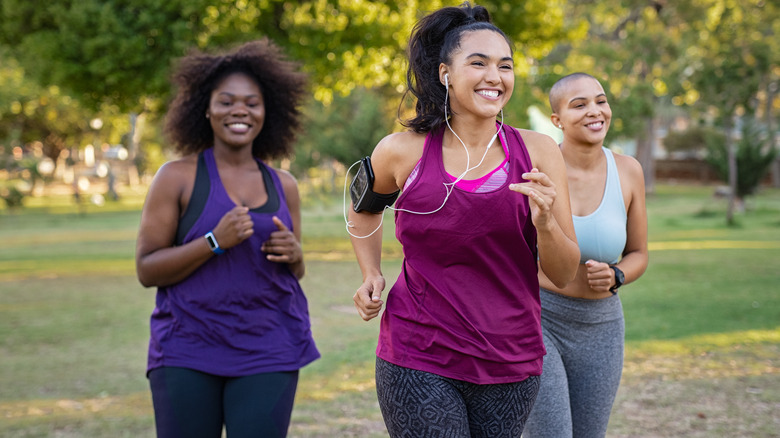Everything You Need To Know About LISS Training
It's no secret that high-intensity interval training (HIIT) pretty much took over the fitness industry a couple of years ago. Ask any HIIT junkie why they love this workout style, and they'll likely list time as one of the factors. HIIT workouts are designed to be quick and effective, allowing you to burn tons of calories without spending hours at the gym. While this might sound perfect to some, others don't find this hardcore workout style to be much fun (the burn is very real) or can't safely do it because of previous injuries.
Enter LISS (low-intensity steady state) training. This workout style has been gaining popularity, and for good reason — it is accessible to everyone. Whether you simply don't like high-intensity training or are just starting on your fitness journey, LISS is an easy, unintimidating workout style for people of all ages. Even if you're a HIIT junkie, combining LISS with your intense workout regimen can do wonders (via Everyday Health).
LISS might seem like a brand-new workout style, but it's not. In fact, it refers to the exact type of exercise that the U.S. Department of Health and Human Services recommends in its Physical Activity Guidelines. "Simply put, you can think of LISS exercise as what public health professionals have been promoting for decades — exercise that is aerobic in nature — such as walking, cycling, and swimming," Peter Katzmarzyk, Ph.D., told Everyday Health.
Interested? Read on for everything you need to know to kickstart your LISS training regimen.
What is LISS training?
You can think of LISS training as the opposite of HIIT. Yes, LISS training still focuses on cardio, but it's much less intense — instead of your muscles being on fire for 20 minutes, you'll be doing an exercise for longer periods of time at a much slower pace while still improving your aerobic endurance (via Byrdie).
Many might see LISS as an inferior style of training when compared to HIIT, but personal trainer Kayla Itsines says that is most certainly not the case. "[T]his type of exercise has become a lot more popular among women," she explained in a blog post she wrote for her website, adding, "However, low-intensity cardio exercise has been used by many professionals in the fitness industry for a long time as a way to complement intense training sessions."
Instead of trying to get as close to your maximum heart rate as possible, LISS requires you to perform at about 50% to 70% of your maximum, depending on your fitness level (via Everyday Health). Speaking to Livestrong, sports and conditioning coach Mike Robertson said that people should aim for around 120 to 150 beats per minute for the duration of a LISS workout. To get an idea of what your maximum heart rate is, you can deduct your age from 220 and then figure out your ideal heart rate for LISS workouts from there.
What's the proper way to do LISS training?
The world seems to have HIIT down to a T, but how do you ensure that you do LISS training properly? The good news is that you actually don't need a trainer or a workout app. "LISS is pretty straightforward because you maintain the same intensity throughout the workout," NASM-certified personal trainer Brie Ogletree told Byrdie. If you don't own a fitness watch or tracker, she recommends simply listening to your body while exercising to gauge the intensity of the workout. Think of the amount of effort you're putting in on a scale of one to 10 — one being the least amount of effort and 10 being your maximum. Aim to keep the intensity of your workout between five and six.
Ogletree says one of the benefits of LISS is that there are many styles of exercise to choose from — you can even go rollerblading or dance around your bedroom — but that it's important to always warm up for any type of workout. It might be tempting to work out for longer periods of time when you do LISS, especially if you're pretty fit and don't feel exhausted after an hour, but Ogletree says that going any longer than 60 minutes kind of defeats the purpose of this training style, and will put more strain on your body than intended.
What type of workouts qualify as LISS training?
As previously mentioned, there are a wide variety of workouts to choose from when opting for LISS training, but some of the most popular ones include hiking, swimming, walking, and cycling, according to Women's Health. These workouts can be pretty intense depending on how you approach them, so make sure not to go too hard — you still need to be able to speak comfortably throughout the exercise. Being too out of breath to hold a conversation means you're venturing into high-intensity territory.
Not all of us have the luxury of venturing outside to exercise, but that doesn't mean you can't incorporate LISS into your routine. Personal trainer Kayla Itsines told Women's Health that you can easily swap more traditional LISS exercises for a quick yoga session or just do some static marches while watching your favorite show. When first starting out, she recommends dedicating specific blocks of time to complete your LISS workout. "Set a 15-minute timer or a 20-minute timer and go for a walk and when it goes off, come back," she recommends. "It's a really good way to break up your week and still stay active and motivated to do more."
Can LISS training help you lose weight?
While LISS might seem too "easy" to actually burn fat, personal trainer Kayla Itsines says that it can actually help you lose weight faster in some cases. In an article for her blog, Itsines explains that doing low-intensity cardio can burn fat more efficiently than HIIT in some instances. "While HIIT can be great for burning stored body fat and calories in a short amount of time, LISS is an important addition to your workout routine because it helps your body metabolize fat — something that HIIT doesn't do," she wrote, adding that low-impact exercise provides your body with more oxygen throughout the workout, which helps burn more fat.
However, there's more that goes into losing weight than just exercise; you also need to pay attention to your eating habits so you stay in a calorie deficit. "This energy deficit needs to be achieved through consuming less calories than you are expending, or expending more calories through exercise," performance coach and nutritionist Lily Chapman told woman&home.
That doesn't mean you should only opt for LISS exercises. While it most certainly is effective, Itsines warns that overdoing it with this workout style can lead to your body starting to burn muscle for energy, which is the last thing you want. She recommends doing LISS alongside other styles of exercise, like HIIT, to get the best results.
How many times a week can you do LISS training?
Starting a workout regimen from scratch or incorporating a new training style into your existing fitness routine can prove challenging, especially if you can't afford a trainer, but it doesn't have to be complicated.
If you have an existing fitness routine, Equinox UK Group Fitness Manager Michelle Morrey suggests incorporating LISS to achieve longevity in your training and to avoid incorporating too many high-intensity workouts into your routine. "Ideally, only 20% of your workouts should be high-intensity," Morrey told Women's Health. "'Whether you're an Olympic athlete or a mum, it's the same. Say you work out five times a week — only two sessions should be HIIT. If HIIT is not carefully controlled, it can lead to injury," she warned.
This is where LISS comes in — not only is it great exercise, but it also balances out the intensity of HIIT. The owner of Performance University, Nick Tumminello, explained to Livestrong that LISS is perfect for active recovery: Instead of taking a full rest day in between HIIT sessions, you can incorporate LISS to give your body time to recuperate while also staying active.
Healthline recommends that beginners do LISS three times a week. People who have already achieved intermediate or advanced fitness levels can opt for two LISS and two HIIT sessions a week, along with two to three strength training sessions.
How long should a LISS workout be?
LISS workouts are usually longer than those associated with HIIT training, but how long should a typical LISS session last to be effective? Well, it varies depending on your fitness level, your goals, and the type of exercise you do. If your main goal is to burn calories, you'll need to put in more time.
"LISS workouts can be as short as five minutes or as long as 60 minutes depending on your fitness level and goals," NASM-certified personal trainer Brie Ogletree told Byrdie. If your goal is to get moving and improve your fitness levels, doing LISS for 30 to 60 minutes a day is ideal.
While 60 minutes of exercise might seem overwhelming, you'll soon realize that it's not as tough as you think, thanks to the gentle nature of LISS training. Speaking to Cosmopolitan, Katie Anderson, head of training at FLY LDN, explained that you can also break up your time in a way that works for you. "If you're doing LISS as part of a circuit, you need to be working out at each station for at least 10 minutes to burn fat," she explained. "If you're sticking to one cardiovascular machine, then around 30 to 60 minutes at a steady pace is ideal."
Is LISS the right workout style for you?
Harder workouts are often seen as more effective. If you're still skeptical about LISS because it seems way too easy, personal trainer Luke Worthington says you should think again. "Typically, HIIT sessions have appealed to those who are time-poor people who need to fit in a short and effective workout," he told Women's Health. "But HIIT can actually cause more pressure, as it's a high-stress mode of exercise for the body but also for the mind and the nervous system."
The last thing you need to do when you're stressed is add more pressure, and this is exactly what HIIT does. Worthington says that LISS training can be more beneficial to those who have stressful lives because instead of firing up the nervous system even more, it activates the parasympathetic nervous system, helping the body to relax.
LISS is also a great option for those who struggle with joint pain and find high-impact exercises to be challenging or painful. "LISS cardio is safe for joints because it's a low-impact exercise and it accommodates for declining coordination, which is another natural symptom of aging," women's personal training specialist Bea Franchini told woman&home. However, for best results, you should combine LISS with other workouts. LISS exercises typically don't require a full range of motion for the joints, so it's important to introduce other exercises to keep joints healthy, Franchini says.
What workouts work best alongside LISS training?
LISS is most effective when combined with other types of movement — and so you're probably curious about which exercises best complement this workout style. The answer will depend on your fitness goals, as Katie Anderson, head of training at FLY LDN, told Cosmopolitan. If your main goal is weight loss, she recommends incorporating some HIIT into your routine. According to Anderson, combining LISS and HIIT will provide a balanced workout regimen that will keep your body in tip-top shape. Thanks to the variety of movements both exercise styles will introduce, you'll notice an improvement in your mobility and strength over time. As a bonus, you'll also improve your cardiovascular health.
LISS also works great when combined with strength training, NASM-certified personal trainer Brie Ogletree told Byrdie. You can incorporate LISS on rest days to help your muscles recover faster. LISS workouts increase blood flow, which, in turn, helps to heal the microscopic tears in your muscles, according to a 2019 study published in the Sports journal. This means adding LISS to your fitness routine can help you tackle your next workout without any soreness, thus maximizing your results.
How can you maximize your LISS training results?
If the fitness junkie in you wants to know how to get the best results out of every LISS workout, we got you.
Combining LISS with other exercises will ensure you reap the best results, especially if you do it directly after an intense HIIT session. "For maximum benefit, it is important to strike a balance between low-intensity and high-intensity exercise," Katie Anderson, head of training at FLY LDN, told Cosmopolitan, adding that this exercise combo will help you lose weight faster. When you follow up a HIIT workout with LISS training, your body can get rid of more stubborn fat because the combination of HIIT and LISS helps "break up the triglyceride bonds within more stubborn adipose tissue," Anderson explained.
Nick Tumminello, the owner of Performance University, agrees with Anderson's approach, saying that people often see HIIT and LISS as two very separate workout styles when in reality, they actually complement each other. Tuminello agrees that it's important to combine LISS with other forms of exercise — however, it's fine if your goal is simply to move your body and have a conversation with your friends while doing it, he told Livestrong. After all, the best type of exercise is the sort you enjoy doing.
What are the benefits of LISS training?
While all workout styles have different benefits, LISS is appealing because everyone can do it and see results.
LISS is excellent if you're just starting out on your fitness journey and want to ensure that you have a solid foundation, personal trainer Kayla Itsines writes on her blog. She adds that LISS is also easy to stick with since it doesn't require tons of effort, which makes it feel less like a chore.
LISS can also help improve your mental health, according to a 2015 study published in Sports Medicine-Open. The study found that those who engaged in low-impact exercise not only reaped physical benefits, but also saw an improvement in depressive symptoms. LISS can also drastically improve your cardiovascular health and fitness, performance coach and nutritionist Lily Chapman told woman&home. Because LISS isn't very intense, it's also easy to incorporate into an existing workout program and tailor it to your specific goals, she added.
Another surprising benefit of LISS is that it's an excellent style of training for those going through menopause. A 2009 study published in the American Journal of Physiology found that aerobic exercise (like LISS) can help prevent age-related muscle loss in older women. "It can be particularly good for women going through menopause because it burns fat and builds muscle in a safe way," explains women's personal training specialist Bea Franchini (via woman&home). "It also might be more accessible for those who haven't exercised regularly for some time."
Are there any drawbacks of LISS training?
One of the biggest downsides of LISS training is probably that it takes up a lot more time than other types of exercise, according to Healthline. Because the workouts are longer and usually repetitive, it's also easier to become bored and unmotivated. Doing things to make it more fun, like inviting a friend to walk with you or listening to an audiobook or podcast, can keep you looking forward to your LISS workouts.
Something else to keep in mind is that because of its repetitive nature, some LISS exercises could lead to overuse injuries, especially if you do the same workout all the time. That's why it's good to switch things up every now and then — instead of going for a walk, dust off your bicycle and explore new parts of your neighborhood, and remember to incorporate other styles of exercise as well.
Also, LISS might not be the right primary workout for you if torching calories is your main goal. Speaking to Marie Claire, certified strength and conditioning coach and personal trainer Alex Adams explained that while LISS offers tons of health benefits, weight loss will take longer than with higher-impact exercise routines. "You would have to spend a long time doing LISS cardio –- like, two hours or more per workout -– to see fitness results or weight loss," he said.
What are the key differences between LISS and HIIT?
Even though LISS and HIIT workouts are both cardio-based, there are some fundamental differences between the two.
"HIIT focuses on quick bursts of high-intensity cardio followed by a rest period," personal trainer Kayla Itsines explains in an article on her blog. She uses the example of walking on a treadmill: If you want to turn it into a HIIT workout, you'd sprint as fast as you can for 30 seconds and then rest for a very short period of time before doing it again and repeating for around 10 to 15 minutes. Because HIIT is so intense, your body might go into what is called the "after-burn effect," where it continues to burn calories long after the end of your workout. The scientific name for this phenomenon is the EPOC (excess post-exercise oxygen consumption) effect. This happens when your body's metabolic rate increases, health and fitness expert Pete McCall told Livestrong, adding that HIIT works best to initiate this process.
LISS, on the other hand, has a strong focus on keeping the heart rate only slightly elevated for a prolonged period of time. Instead of requiring short bursts of intense activity, LISS consists of sticking to a comfortable pace for 30 to 60 minutes. This type of workout also burns calories at a slower rate, which means much longer sessions are required to burn the same amount you would during a quick HIIT session, McCall wrote in an article for ACE.
